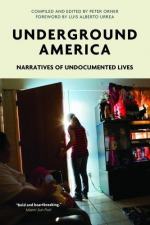|
This section contains 692 words (approx. 2 pages at 400 words per page) |

|
Underground America: Narratives of Undocumented Lives Summary & Study Guide Description
Underground America: Narratives of Undocumented Lives Summary & Study Guide includes comprehensive information and analysis to help you understand the book. This study guide contains the following sections:
This detailed literature summary also contains Topics for Discussion on Underground America: Narratives of Undocumented Lives by Orner, Peter.
The following version of the book was used to create this guide: Underground America: Narratives of Undocumented Lives. Edited by Peter Orner. Voice of Witness. Verso, 2017.
Edited by Peter Orner, Underground America: Narratives of Undocumented Lives presents the stories of 24 undocumented immigrants living in the United States. The forward, “All Stories are Refugees from Dangerous Lands,” by Luis Alberto Urrea encourages the reader to prioritize listening and understanding before judgment and decision on issues of immigration. The introduction by Peter Orner, “Permanent Anxiety,” provides the reader with an understanding of how and why the stories were compiled in the manner that they were.
Diana is the first narrative. She talks about her experience immigrating from Peru and working to clean up Mississippi after Hurricane Katrina. Mr. Lai, from China, discusses his reasons for leaving China and his attempts to pay off loan sharks back home. Saleem was deported to Pakistan after being falsely accused of a connection to 9/11.
From Mexico, Roberto came to California to build a life with his wife and daughter, who were eventually deported back to Mexico. Roberto continues to live in the U.S. and is now documented. Liso, a former schoolteacher in South Africa, initially came to the U.S. as a missionary, only to be forced into grueling, low-paid work as a nanny and housekeeper. Hector worries about an impending immigrant raid of his neighborhood.
Olga, a Mexican housekeeper, mourns the loss of her transgender daughter, who was imprisoned and denied her HIV/AIDS medication. Meanwhile, Abel, an indigenous Guatemalan, fled massacres in Guatemala to come to the U.S. Polo, from the state of Oaxaca in Mexico, also helped to rebuild Mississippi after Hurricane Katrina, without ever receiving compensation.
Dixie, a Colombian-born educator in Cali, comes to the U.S. looking for better opportunities. She marries there, and quickly falls victim to the domestic abuse of her American husband. El Curita comes to the U.S. in hopes of sending money home to his family. Instead, he falls under the control of La Americana, a violent and domineering woman who exploits his labor. Julio describes the time he got lost for four days in the desert.
Lorena, who was brought to the U.S. when she was six years old, is a 22-year-old college student and employee of a real estate firm. She fears deportation and losing her employment, since she lacks a social security number. El Mojado moved from Mexico to Kansas City, where he struggles to make ends meet through various factory jobs. Yogesh, who was brought from India to the U.S. when he was eleven years old, also fears deportation to a country that he hardly knows anymore.
Jose Garcia, who was pressured into immigrating while a young teenager, has emerged from jail and is now working as a substance abuse counselor and cook. Elizabeth, a teacher from Bolivia, has come to the U.S. in search of medication that her severely arthritic teenage daughter needs. She ends up in jail, and is eventually deported back to Bolivia. Nsombo, a Cameroon immigrant, is stuck in jail and resents his treatment in the U.S. as well as the ineffective yet costly lawyers he has been forced to hire.
Desiree came to the U.S. from Mexico as a teenager, overstayed her visa, and has since settled into a life in Berkeley with her girlfriend and daughter. She fears deportation. Farid, a 62-year-old immigrant from Iran, has built a successful business in the U.S. yet lacks papers. He is eventually granted political asylum. Rose left her son in China to build a life in the U.S.
Adela is a Mexican-born housewife, mother of five daughters, and increasingly outspoken immigrant rights activist. Despite her fears, she wants to be a good example for her daughters. Her daughter, Estrella, was brought to the U.S. as a baby. Like her mother, she fears deportation but plans to build a life for herself in the U.S. Enrique, who is 60 years old, recently came to the U.S. but struggles to find work as a day laborer due to his age.
Read more from the Study Guide
|
This section contains 692 words (approx. 2 pages at 400 words per page) |

|



